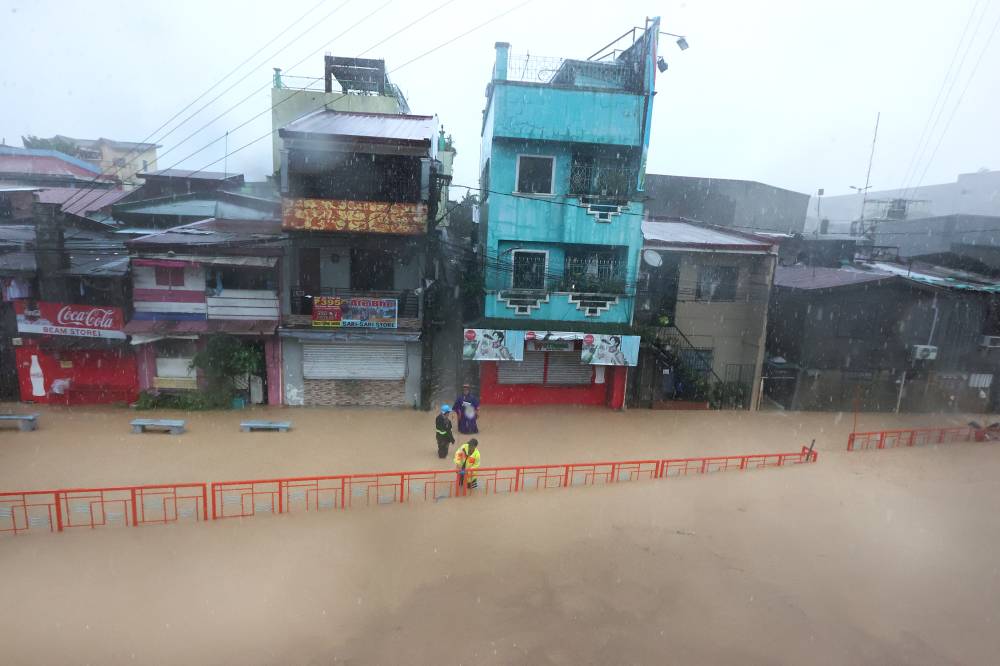12 years after Habagat 2012, some things never change

“Habagat“ (Southwest monsoon) brings heavy rainfall, which leads to flooding in Metro Manila and nearby provinces. Have we adapted to this new norm? Or even better, have we learned our lessons?
Our recent experience with Supertyphoon “Carina” and Typhoon “Enteng,” which enhanced the impacts of habagat, only proves that the world’s climate has changed drastically because of our use of fossil fuels, which emit heat-trapping gases blamed for climate change.
Habagat has become more than just a seasonally prevailing wind that blows from June to October. It is a disruptive weather system that has grown in ferocity over the years, acquiring typhoon-like impacts since 2012, when most of Metro Manila became a waterlogged zone due to torrential rains that overwhelmed the capital region’s pumping stations.
That year, Luzon was battered by torrential rains and thunderstorms for eight days straight, from Aug. 1 to 8, and the sky remained dark and misty for days after. Although the hardest hit was Metro Manila, Habagat 2012 cut a wide swath that inundated the Calabarzon region and Central Luzon with heavy rainfall. It didn’t help that Typhoons “Gener” and “Hanna” further strengthened Habagat 2012, which dumped more rain into the already saturated areas in Luzon.
In that year, too, the government acknowledged the growing helplessness of residents of the capital and nearby provinces due to the unpredictability of habagat and the devastating impact of over a dozen typhoons that hit the country annually.
Although not considered a storm by definition, Habagat 2012 led to the deaths of 109 people and left behind a trail of destruction that cost the country P3 billion, according to the National Disaster Risk Reduction and Management Council.
Working as a reporter for the Inquirer at that time, I covered then President Benigno Aquino III as he made a four-hour swing through evacuation centers in Nangka, Marikina, Bagong Silangan, Quezon City, Gen. T. de Leon, Valenzuela and Poblacion, Navotas. (Read “3 antiflood projects to rise in Laguna, Marikina, Camanava” (8/10/2012).

Residents near the riverbank evacuate to higher ground as the swelling Marikina River in Marikina City reaches the third alarm on Wednesday, July 24, 2024 due to the heavy rainfall brought about by Typhoon “Carina” and the enhanced southwest monsoon or “habagat.” INQUIRER PHOTO / GRIG C. MONTEGRANDE
Master plan
Fast-forward to 2024, the Department of Public Works and Highways asserts that there is no integrated master plan for flood control in Metro Manila despite the billions of pesos previously allocated for it.
The 5,500 completed projects, said Public Works Secretary Manuel Bonoan, were just “immediate relief projects and engineering interventions all over the country that are not part of the master plan.”
But this piecemeal approach to mitigating flooding is precisely what our government has abandoned since the Aquino administration after Habagat 2012, prompted by scientific findings that climate change will cause chaos in the coming years. And flooding is the most significant challenge facing Metro Manila, where many areas are below sea level.
In addition to upgrading the pumping stations operated by the Metropolitan Manila Development Authority, the Aquino administration had planned to install embankments and catch basins in the Marikina watershed, and an 8-kilometer dike in the Camanava (Caloocan, Malabon, Navotas, and Valenzuela) area, and a ring-road dike along Laguna de Bay.
In 2012, a P351-billion long-term flood management master plan was approved to flesh out these plans, which include the proposed Marikina Dam, Parañaque Spillway, and Manggahan Control Gate Structure, which can block floodwaters from Sierra Madre from entering Pasig and nearby cities.
If these mega infrastructure projects had been executed as planned, the master plan would have gradually alleviated the flood-prone eastern, northern, and southern areas of the National Capital Region during habagat.
Scientists have long warned that extreme weather events will become increasingly common as the climate crisis accelerates, and that “global warming actually changes the properties of precipitation in terms of frequency, intensity, and duration,” CNN quoted Jung-Eun Chu, an atmospheric and climate scientist at the City University of Hong Kong in 2023 (Source).
But following the onslaught of Carina in July this year, Bonoan admitted in a radio interview that there was a master plan, although only less than 30 percent of it had been completed. Why did Bonoan change his tune when he faced the Senate in August?
Even Surigao del Sur Rep. Romeo Momo issued a statement last July 26 confirming the existence of a $500-million Metro Manila Flood Management Project being funded by the World Bank and the Asian Infrastructure Investment Bank. However, “many of the projects are yet to be bidded out and some are still ongoing. We need to double time with our flood infrastructure projects. The money is already available.” (More on the master plan in my next column.)
For comments: mubac@inquirer.com.ph


















